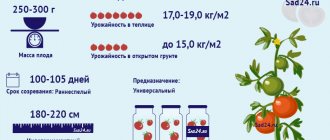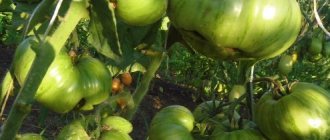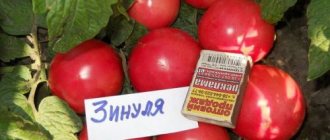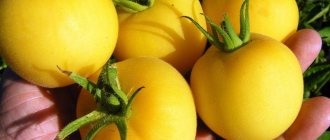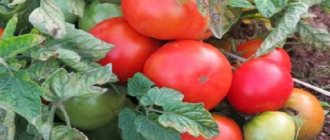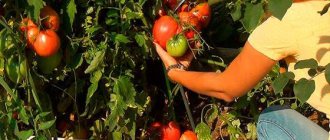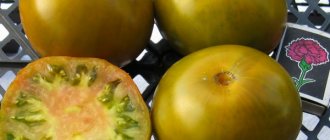The pride of Siberia is one of the best tomatoes for growing in conditions where cold snaps and even light frosts are possible in summer. There is something to be proud of – giant tomatoes, strong resilient bushes, endurance to adverse factors.
| Height | Landing location | Ripening time | Fruit color | Fruit size | Origin | Fruit shape |
| Tall | Greenhouse, Open ground | Early ripening | Reds | Large | Variety | Flat-round |
Description and characteristics of the variety
Tomato Pride of Siberia is a determinate standard variety and is classified as tall. The length of the shoots reaches 1.5 m.
Ripening dates are early - 85-100 days from germination.
Tomatoes are round in shape, slightly flattened on the sides. They resemble a smaller version of a pumpkin. The ribbing is moderately pronounced. There are few seed chambers - 6-7. The color of the skin and pulp is bright red. When broken, the fruits are fleshy and sugary, but not watery.
The average weight of tomatoes varies in the range of 750-800 g. The largest fruits grow up to 950-1000 g. The taste is sweetish, harmoniously combined with sourness.
Agricultural technology
The love for this variety among summer residents is associated with its unpretentiousness. Therefore, even novice gardeners can afford to grow this variety, the main thing is that they have basic skills in caring for cultivated plants.
The soil
Table tomatoes need fertile, oxygen-rich soil. The main parameter is neutral acidity.
The place for permanent landing should be very well lit. The proximity of groundwater is unacceptable.
Growing seedlings
In order not to replant the seedlings several times, it is better to immediately place the seed in any suitable container.
Planting seeds
Features of growing seedlings:
- Seeds are sown in the ground no earlier than the last week of February.
- The first shoots appear 7 days after planting.
- Picking is no different from other varieties. This is done after the first true leaves appear.
- The soil should not dry out. Excessive hydration is not recommended. Abundant watering no more than once a week.
- Feeding with nitrogen, phosphorus and potassium is required. To do this, you can buy any fertilizer suitable for tomatoes.
The time of planting at a permanent place of growth depends on certain circumstances. If this is a greenhouse, then 70 days after planting the seeds, the seedlings are ready for transplanting.
When planting in open ground, you need to monitor the weather. If it is cold, and it is impossible to plant 2 months after the appearance of the first shoots, then the growth of seedlings must be artificially stopped. This is done by lowering the room temperature to 15 degrees. You can also reduce the operating time of the electric paw. After the weather has stabilized, the seedlings are planted in a bed that is pre-fertilized with dolomite flour.
Disembarkation
When planting seedlings, it is worth considering that the variety is tall and bushy. Therefore, there should not be more than 2-3 plants per 1 square meter. The rows are made at a distance of 50-60 cm from each other. 70-80 cm is maintained between the bushes. One seedling is placed in one hole.
Saplings
It is better to immediately stick a reliable trellis or support next to the plant. The soil around the tomato needs to be mulched with straw or hay.
Care
The plant needs pinching in order for it to form one fairly strong trunk. The formation of two trunks is acceptable, but no more. To get a high yield, it is necessary to remove stepsons at least once every 7-10 days. If this is not done, the fruits will be small and the yield will decrease sharply.
Usually the hybrid bush blooms wildly. But you can’t leave all the flowers. There is a rule: there are no more than three flowers in an inflorescence. More than five ovaries should not be left on one hand. It is also necessary to carefully monitor the formation of brushes. As new ones form, it is necessary to thin out the old ones.
Trimming
As the plant develops, the lower leaves need to be removed. So, at the moment of ripening of the fruits on the first cluster, all leaves lower down the trunk should be completely cut off.
The soil around the trunk should always be loosened. Weeds are not allowed to grow and must be destroyed immediately.
Watering
This hybrid loves the sun very much, but does not tolerate watering in the hottest part of the day. Also, do not water the entire plant. Water is directed only to the root. She shouldn't be cold.
Indoor rose - care at home, why it dries
Watering is carried out in the early morning hours or after six in the evening, no more than 2 times a week. If the weather is not dry, one watering for 7 days is enough.
Watering tomatoes
Top dressing
It all depends on the saturation of the soil with useful microelements. If the soil is well fertilized in autumn and spring, the plants do not need frequent feeding. If the soil is “poor,” then already 2 weeks after planting the seedlings, you can water the hybrid with mineral fertilizer or mullein solution.
Plant growth can be stimulated using nitrogen fertilizer (urea). Usually, once 3-4 weeks after planting the seedlings is enough. Potassium fertilizing will not hurt. It should be carried out 2 times during the entire period:
- At the moment of the appearance of the first flowers.
- When ovaries appear.
The gardener needs to carefully monitor the overall appearance of the plant. If it develops poorly or loses its bright green color, then additional feeding may be needed.
Features of cultivation and storage
The seedlings are transplanted at the age of 50-60 days into permanent beds. The soil is well fertilized, applied per 1 m2:
- compost 5 kg;
- superphosphate 30 g;
- potassium salts 15 g;
- wood ash 1 cup.
4-5 plants are planted per 1 m2. They are formed into 2 stems and planted regularly - once every 10-12 days.
Care features include:
- watering 6 liters at the root 2 times a week;
- fertilizing with “Kemira” or “Solution” 2 times a month, always during flowering, ovary and ripening;
- mulching with a layer of 10 cm.
How to grow tomatoes
After the soil warms up to 15 °C, the seedlings are transplanted into the ground. By this time, the bushes have 5–7 true leaves. The soil for planting is prepared in advance: it is dug up and mineral fertilizers are applied.
Landing
No more than 5 seedlings are placed per 1 m2 in a checkerboard pattern. This method of arrangement helps each bush to receive a sufficient amount of sunlight and does not interfere with ventilation.
The holes are made no deeper than 20 cm and filled with warm water. After transplantation, the soil is moistened again and left to adapt for 2 weeks.
Reference ! While getting used to a new place, seedlings are not watered, as they are not able to absorb moisture. All the forces of plants go into adaptation.
Further care for tomato
Regular watering is established as rooting occurs in a permanent place. Moisten the soil abundantly and often, but only with warm, settled water. Seedlings should not be flooded, otherwise increased moisture will provoke the development of fungal diseases. Excess liquid also negatively affects the roots, which can rot.
After watering, the soil is loosened and weeds are removed. Weeds take away many of the nutrients needed for seedlings to grow. In addition, they hide a large number of pests that can cause great damage to tomatoes.
To retain moisture, the beds are mulched with dry leaves, straw or weeds. When the grass rots, it supplies the plant roots with additional nutrition.
Timely application of fertilizing guarantees a high-quality harvest. The crop is fed at least 3 times per season. At the stage of ovary formation, a full complex of minerals with a predominant content of potassium and phosphorus is used as fertilizing. During the flowering and fruiting period, the mineral complex can be replaced with organic matter: for example, aquatic bird droppings or mullein infusion in a ratio of 1:15.
Features of care and possible difficulties
To prevent the fruits from being small, the plant should be formed into 1 or 2 stems. The shaping of the bush also affects the quantitative indicator of fruiting: if the side shoots are not removed in a timely manner, the harvest is significantly less. In addition, an excessive number of stepsons leads to thickening of plants, which negatively affects further development.
The shoots are removed before they reach 5 cm, otherwise the procedure will not be painless for the tomatoes. Plants are planted in the morning so that by evening all the wounds have time to heal. After removing the shoots, the cut sites are treated with a weak solution of potassium permanganate or sprinkled with ash.
Despite the fact that the type is determinate, seedlings without additional support will not withstand the weight of ripe vegetables. During transplantation, wooden pegs or metal rods are installed next to each bush, to which the stem is immediately attached. Fruitful branches are tied to a support as they develop.
Diseases and pests
For tomatoes, the most dangerous attacks are whitefly and spider mites. Spider mites live mainly in greenhouses, since the most favorable conditions for them in terms of temperature and humidity are created there. To eliminate it, it is enough to ventilate closed structures every day. Fresh air destroys the pest’s usual habitat.
Pawpaw three-lobed banana tree Growing and care in open ground
Pheromone traps installed near the seedlings help against whiteflies. She is also repelled by plants with strong odors, for example: calendula, onions and garlic. Therefore, they are planted next to tomato beds. When there is a large concentration of parasitic insects, use the insecticide “Confidor”, dissolving 1 ml in 10 liters of water. This drug is also used for preventive purposes.
The crop has strong immunity to nightshade diseases, so preventive measures are quite enough to keep the seedlings healthy throughout the season.
After transplantation, young plants are sprayed with a weak solution of potassium permanganate. Further actions boil down to moderate watering, systematic loosening and weed removal.
To prevent fungal diseases, fungicidal agents such as Fitosporin and copper sulfate are used. Any copper-containing preparations are also suitable for treating plants.
According to the rules of crop rotation, it is not recommended to plant tomatoes next to potatoes. Such proximity leads to negative consequences. These two crops belong to the same nightshade family and are affected by the same diseases and pests.
Pests and diseases of tomato Pride of Siberia
The variety is sufficiently resistant to most diseases.
However, the fruits can become rotten and crack. Rotting of tomatoes usually occurs upon contact with the ground, so the simplest preventive measure is tying the bushes to supports and mulching the soil during the fruiting period with a thick layer of pine needles (straw, sawdust). Fruit cracking is considered a disease, but it does not occur due to the influence of any microorganisms, but simply under unfavorable environmental conditions. The incidence can be reduced with the help of an adjusted watering regime (the soil should not alternate between drying out and high humidity).
Of the pests, the variety is most often affected by the greenhouse whitefly. This prolific pest not only causes direct damage to plants by sucking the juice out of them, but is also the cause of sooty fungus.
The greenhouse whitefly is the most common “guest” of tomatoes in greenhouses
To prevent damage by this dangerous pest, at the end of each season it is necessary to treat all parts of the greenhouse structure with bleach, carefully remove plant debris and dig up the soil. If the whitefly does attack your tomatoes, you can fight it mechanically - remove insects and egg clutches by hand, wash them off with a stream of water, or collect them with a vacuum cleaner.
Caring for tomatoes “Pride of Siberia”
After planting bushes of this variety in a greenhouse, you need to continue to monitor their condition and provide the plants with proper care. For active growth and flowering, you need to remove weeds, apply fertilizers and properly water the plants.
Feeding and watering
After transplanting into a greenhouse, young bushes should not be watered for 10–14 days so that the root system adapts to the new conditions. After this period, the tomato bushes are watered frequently and abundantly as the soil dries.
Watering is carried out early in the morning or in the evening, closer to sunset. Even in hot weather, only warm water should be used to irrigate tomato bushes.
Important! It is necessary to take the necessary preventive measures to prevent some tomato diseases and possible pest attacks. Feeding tomato bushes with fertilizers is an integral part of a good harvest.
Feeding tomato bushes with fertilizers is an integral part of a good harvest.
The following are suitable fertilizers for the Pride of Siberia tomato variety:
- rotted manure;
- bird droppings;
- a solution of water and mullein;
- ready-made mineral fertilizer complexes;
- phosphorus;
- potassium.
After successful adaptation of the seedlings to greenhouse conditions, the tomatoes are fertilized with organic types of fertilizers from the given list. They contain nitrogen necessary for the growth of leaf mass. And at the stage of ovary formation, phosphorus-potassium fertilizers are applied, which contribute to the formation of tasty and large tomatoes.
Stepsoning
Tomatoes of this variety are large in size only if the bush is formed correctly. For best yield, it is recommended to grow the plant with 1 or 2 stems. Excess side shoots and branches must be trimmed. This should be done every week, cutting off excess shoots before they reach a length of 3 cm.
If you do not prune, there will be much fewer tomatoes on the bush, and their size will be small. It is best to prune the bush in the morning so that the sun can dry the cut area during the day.
Loosening the soil and weeding
In order for young tomato bushes to grow quickly and gain strength for flowering, you need to weed the soil around them. Weeds growing near tomatoes can block the sun and drink most of the moisture from the soil along with applied fertilizers and nutrients.
Growing bushes of the Pride of Siberia variety need a lot of free space around, and weeds can limit the freedom of growth of tomatoes too much. Therefore, weeds must be removed immediately after their appearance.
Did you know? Tomato roots can penetrate the soil to a depth of 1 m and grow laterally to a distance of up to 2.5 m.
For better air exchange and uniform saturation of the soil with water, the soil around the tomato bushes should be loosened at least once a month. It is best to do this procedure immediately after watering the bushes.
Pest and disease control
The Pride of Siberia variety is resistant to many tomato diseases. But some diseases and pests can still attack the plant and reduce the yield of tomatoes.
List of the most common problems with tomatoes of this variety:
- Cracking tomatoes. It occurs if you water tomato bushes too much. To treat and prevent this problem, you need to water the plants moderately, avoiding too much moisture in the soil.
- Attack by the common whitefly pest. Leads to damage to leaves on tomato bushes and provokes the death of the plant. For treatment, ready-made drugs against this pest are used, for example, “Confidor”. Tomato bushes are irrigated with the prepared solution. For prevention, you need to add fertilizer containing saltpeter to the soil.
- Damage to bushes by wireworms. Most often it occurs when growing tomatoes outdoors, but sometimes the pest is also found in a greenhouse. To prevent the appearance of wireworms, tomato seeds are treated with special disinfectants before planting. You should also not place a greenhouse with tomatoes near potato fields. To distract wireworms from tomato bushes, you can bury wooden sticks with vegetables strung on them in places where pests accumulate. After the wireworms come running for this delicacy, remove the sticks from the ground and burn them.
- Late blight. To prevent disease, the greenhouse should be periodically ventilated and the humidity level should not be too high.
Productivity
Tomatoes are harvested as they ripen. They are picked from the bush and placed in clean wooden or plastic boxes, carefully sorted and taken to a dry, cool room.
Tomatoes of Siberian selection ripen early. For this reason, the berries are picked ripe when they turn red and become soft. Harvesting usually occurs between July and September. In a summer greenhouse, where heating is not provided, tomatoes begin to ripen around mid-July.
For long-term storage, remove the fruits from the bush along with the stalk. The harvested crop is well stored and survives transportation without any problems. Berries must be stored in a dry, dark and cool room (cellar or basement).
Place the tomatoes in wooden or plastic boxes. Try to stack the berries so that they do not touch each other. As you can see, “Pride of Siberia” has a lot of advantages.
Even a novice summer resident will be able to cope with growing the described variety. Tomatoes will delight you with their unpretentiousness, abundant harvest and excellent taste.
Tomato varieties of Siberian selection
The sharply continental climate of Siberia obliges local gardeners to carefully select seeds for planting. After all, the amount of harvest will primarily depend on this choice. This also applies to the vegetable beloved by all summer residents - the tomato. Daylight hours in the northern regions are short and plants accustomed to large amounts of sunlight are unlikely to have time to grow strong and healthy. Therefore, tomato varieties of Siberian selection intended for planting in cold regions must necessarily have one important quality - early ripening. After all, in just three warm summer months the plant must have time to develop and begin to bear fruit. In addition, the taste of the fruit and yield are also important for any vegetable grower. Summer residents expect all these qualities from tomato varieties of Siberian selection. Let's talk in more detail about the tomato varieties recommended for growing in cold regions.
Main differences between varieties
Before you begin directly choosing seeds, you should decide for what purpose and under what conditions the tomatoes will be grown. Some varieties show their qualities better in a greenhouse, while others in open ground. Each variety comes with specific growing recommendations that are best followed if you want to get a rich harvest.
Tomatoes differ from each other in their growth patterns. Indeterminate varieties have a powerful main stem that does not stop developing. Determinate varieties of tomatoes of Siberian selection form a small bush, inflorescences and fruits on which are formed simultaneously. The latter, as a rule, have higher yields.
It is also worth mentioning how a variety differs from a hybrid. Hybrids are obtained by crossing several varieties, and they are significantly ahead of conventional varieties in terms of productivity and unpretentiousness. But already in the second generation, such a plant loses its properties, while varietal tomatoes will consistently produce crops for several years.
The best tomato varieties for the Siberian region
Here are some examples of the best varieties of tomatoes of Siberian selection:
- “Velmozha”
is the largest variety bred by Siberian breeders. It should be grown in a greenhouse. It will begin to bear fruit in about 110–120 days, and the weight of one tomato can reach 1 kg. - “Great Warrior”
variety will allow you to get ultra-early tomatoes. The growing season is only three months. And ripe fruits can weigh up to 500 g. - “Nastenka”
forms compact low bushes and bears large fruits. It is one of the best varieties for growing in greenhouses or under film covers. - “Dubok”
is a determinate, cold-resistant tomato variety recommended for cultivation in northern regions with harsh climates. Designed for open ground. Not afraid even of drafty places. The fruits are small and well suited for canning. - Variety "The Mystery of Nature"
It is distinguished by its peculiar color.
Yellow on the outside and pink on the inside, these tomatoes combine the best of two types of tomatoes: the nutritional qualities of the yellow varieties and the sugary taste of the pink varieties. Harvesting will be possible 110 days after germination.
- “Nikitka”
is a determinate mid-early variety that will begin to bear fruit in 110–115 days. Small, smooth orange tomatoes are ideal for both fresh consumption and pickling. - “Lady fingers”
are determinate, ultra-early tomatoes for open ground or temporary film shelters. The variety ripens in three months. The fruits are small, red, smooth, pear-shaped.
womanadvice.ru
There is a similar article on this topic - Growing tomatoes in a greenhouse and open ground.
Advantages and disadvantages
From one square meter of soil, the farmer harvests about 20 kg of Pride of Siberia tomatoes, therefore, this variety has good yield. Disease resistance, early ripening and unpretentiousness of tomatoes will be a pleasant bonus for a vegetable grower whose goal is to grow a large, high-quality crop.
To get a harvest of beautiful large tomatoes, you will have to pay a lot of attention to tying, because under the weight of heavy fruits, an untied bush cannot stand it and lies on the ground, and contact with the ground spoils the fruits.
Application
Large fruits of the Pride of Siberia variety are not suitable for whole canning. However, they are very tasty and are recommended to be eaten fresh, added to salads and other dishes. Tomatoes are also suitable for processing into sauce, juice, and paste.
Watch the video! Varieties of tomatoes (tomato) in Siberia
“Pride of Siberia” is a table variety with excellent taste. It is ideal for cutting into vegetable salad. It is not suitable for preservation due to the enormous size of the fruit, which exceeds the diameter of the neck of the jar. But it is successfully used for processing into juice or tomato paste.
Low-growing tomatoes for open ground
Varieties bred for the Urals and Siberia are able to withstand unfavorable conditions such as low temperatures, heavy rains and short daylight hours. Varieties for open ground are characterized by a short growing season, compact bush size and unpretentiousness.
Buffalo Heart
Bushes of the determinate type stop growing at a level of a meter in height.
Each plant produces 7-9 kg of fruits with excellent taste. The average weight of a tomato is 500 g. The shape of the tomatoes is heart-shaped, the pulp is juicy with a small number of seeds.
Fruiting is long-lasting, the first harvest will ripen in 100 days.
Bullfinch
An ultra-early tomato, resistant to sudden temperature fluctuations and little sunlight. The bushes do not require garter; the plant height rarely exceeds 50 cm.
Productivity is 6 kg/m2. Round, smooth fruits weighing up to 150 g are painted in a rich red color. The variety is resistant to late blight and drought.
Barnaul Cannery
The tomato is resistant to low temperatures and lack of sunlight. Orange-red, round tomatoes with a dense skin are intended for canning in their entirety.
Friendly ripening occurs after 100 days. The average specimen weighs about 70 g. The bushes are low, up to half a meter high.
Siberian
The tasty and productive variety is unpretentious. Does not require additional support, stops growing after the formation of 5 fruit clusters. The purpose of the fruit is universal.
The Siberian tomato ripens in 3.5 months. Tomatoes weighing up to 100 g have a smooth, round shape and a rich red color.
Buyan Yellow
A tomato that is resistant to cool climates and has high yields. The rich yellow fruits ripen in 3-3.5 months. The compact bush does not require pinching or support.
Thanks to their dessert taste and thick skin, Buyan tomatoes are suitable for salads and whole canning. The weight of an average specimen is 90-120 g.
Bouquet of Siberia
Mid-season variety with compact bush size. On each plant, about 30 tomatoes of the same shape and size ripen at the same time. The weight of each fruit does not exceed 60 g. The surface is smooth, glossy, and red. The universal purpose of tomatoes. Excellent transportability and disease resistance.
Watercolor
Fruit set begins after the fourth leaf. Each brush produces six identical-sized tomatoes. Their shape is oval and their color is bright red. The photographs confirm the accuracy of the description of the variety. A yellowish area stands out near the petiole.
Like any other vegetable crop, Watercolor has its own advantages and disadvantages.
The advantages include:
- unpretentiousness;
- high productivity, independent of weather conditions;
- resistance to a number of diseases;
- high sugar content of the pulp;
- rapid ripening of tomatoes.
The disadvantages of this variety include that the skin of the fruit is too hard, so they are good canned and retain their integrity during heat treatment.
Popular tomatoes for open ground
In open areas, experienced gardeners prefer to plant determinate, low-growing species. After all, such standard plants need much less attention. There is no need to pinpoint them; they all ripen at the same time and are removed from the bush together. The growing season is so short that late blight does not have time to manifest itself.
Sanka
A favorite variety in all regions of Siberia. Vegetables ripen very quickly, within 70 – 80 days. The height of asthenia is 50 – 60 cm. Sanka can adapt to the lack of light. Has immunity to most diseases. The yield is satisfactory, the weight of one tomato is up to 100 g. It is a non-hybrid species, which means you can collect seeds for the next season.
Countryman
The variety is “for the lazy”, absolutely undemanding to care. It is possible to grow without seedlings. Short ripening period (average 100 days). According to descriptions from gardeners, Countryman has a strong immunity to diseases. Good yield (up to 4 kg per bush). The fruits are medium-sized (70–90 g), plum-shaped, and there can be up to 15 of them in one cluster.
Far North
Record holder for yield among standard crops. The first ripe tomatoes are picked just 90 days after emergence. Immune to root and crown rot and late blight. Resistant to worsening weather conditions (lower temperatures, prolonged rains, predominance of cloudy days). The yield of 1 bush is up to 2 kg.
Bull's heart
A large-fruited variety, the tomatoes are heart-shaped. Average duration of ripening (up to 130 days). Height up to 160 cm, pinning and garter required. Productivity from 1 bush is up to 5 kg. One specimen can weigh up to 500 g. It is possible to collect seeds for the next season.
Buyan yellow
Resistant to low temperatures. The plants are small, up to 50 cm high. The pulp is dense, the weight of the tomato is 80 - 120 g, it retains its integrity when pickling and canning, since the skin is very strong.
Demidov
Received by Siberian breeders, well adapted to the local climate. Height – up to 65 cm. Productivity is consistently high. Pink tomatoes, up to 110 g each, have a rich sweet and sour taste. They require regular dosed watering; overwatering can cause cracking of vegetables.
Oak
Frost-resistant and unpretentious variety. The height of the bushes is up to 50 cm. Early ripening, the ripening period is less than three months. High yield. The fruits are round, up to 110 g each, with dense pulp. The harvest has good keeping quality and is easy to transport.
Barnaul Cannery
Early ripening, the first harvest ripens within 100 days. A low-growing plant (up to 45 cm) of a determinate type (does not require pinching). Resistant to sudden temperature changes. The plant forms no more than three brushes, with a maximum of 9 pieces in each. The fruits are small (50 g), oval, with an orange tint. Tomatoes are fleshy, have a sweet and sour taste, ideal for winter preparations.
Bullfinches
A variety of Siberian selection, not afraid of frost. An early ripening species, the first harvest ripens within 90 days. The bushes are low, up to 40 cm. Resistant to temperature fluctuations. The tomatoes are round, bright red, up to 150 g each, do not crack.
Zhenechka
Compact plant, height up to 50 cm. Undemanding in care, but it is advisable to plant it up to the first cluster. The yield of 1 bush is about 2.5 kg. The fruits are small, round, weighing up to 100 g, with a sour taste. It is necessary to collect before the first frost. Bushes rarely get sick, but are quite often affected by pests (Colorado beetle, wireworm, slugs).
Pest Control
The variety is resistant to most diseases, but some ailments can still overtake the “Pride of Siberia”. First of all, there is a danger of fruit cracking; farmers combat this problem by reducing the amount of watering and fertilizing with nitrate-based fertilizers.
If tomatoes are grown in a greenhouse, then the most common and dangerous pest that spoils the crop is the greenhouse whitefly. To combat it, “Confidor” is suitable, which is sprayed on plants in accordance with the manufacturer’s instructions.
When grown in open ground, in most cases, wireworms become the main pest. You can fight them using many methods, but it is more effective to pay attention to preventing their invasion. For this purpose, you should not plant tomatoes close to potatoes, but a few days before planting, lay wireworm traps in the form of potato halves buried 10 cm deep, mounted on a stick, in an empty area. They will attract wireworms. After a few days, you need to take out the traps and destroy them along with the pests, after which you can repeat the procedure.
A prolific tomato variety that will be a good choice for vegetable growers from northern regions who know how to grow tomatoes in greenhouses. Presentable appearance and good taste make “Pride of Siberia” a smart choice if the goal is to get a large harvest of tomatoes for fresh consumption and preparing dishes from fresh vegetables.
Farmer reviews
Favorable reviews of the Pride of Siberia tomato are another big plus. Many gardeners choose varieties for planting based on the characteristics of the crop and reviews from experienced gardeners.
Kristina, Novosibirsk: “The tomato is excellent for growing in the difficult Siberian climate. The fruits are really large, juicy and very tasty. The seedlings do not get sick and are not damaged by pests. I like this species for its sustainability, taste and easy care. I’ve been planting for several years now and I’m happy with everything.”
Anatoly, Krasnodar region: “The weather here is excellent, I sow the seeds directly into the garden bed. Everyone comes up. The seedlings are strong, up to 110 cm high. I form them into 1 and 2 stems. The yield is excellent, 4.5 kg from each bush. This is a good indicator, so I’ve been growing it for three years now and will plant it again.”
Feeding and disease prevention
The frequency of fertilizing depends on how thoroughly the land was prepared before planting. If the nutrition is not enough, 2 weeks after planting, you can water the Pride of the Feast tomatoes with mineral fertilizers or a manure solution.
Nitrogen fertilizing (100 g of urea per bucket of water) is applied during the growth period. When tomatoes begin to bloom, as well as during fruit formation, plants require potassium fertilizers (for example, ash).
Tomato Pride of the feast almost never gets sick, but still the bushes are regularly inspected and, if necessary, treated with drugs: copper sulfate, Bordeaux mixture, calcium nitrate. You can use infusions of garlic, wormwood, and a solution of laundry soap.
ydachadacha.ru
Growing conditions
The Siberian selection tomato is a heat-loving plant. The optimal temperature for breeding is +18–25 °C. In addition to heat, plants must be provided with good lighting. LED energy-saving phytolamps allow you to grow tomatoes in a greenhouse. As for air humidity, the ideal figure is 60–70%.
Tomatoes prefer loose, warm and nutritious soil. The bushes respond positively to soil rich in nitrogen and potassium. It would be a good idea to disinfect the soil by soaking it in potassium permanganate or copper sulfate solution. In addition, tomatoes love slightly alkaline soil: a comfortable reaction is 6.5–7.0 pH (a little higher is acceptable).
Diseases and pests
Despite its disease resistance, this variety can still be affected by some diseases.
Pride of Siberia may be susceptible to fruit cracking. To combat this disease, it is necessary to reduce watering and use fertilizers based on nitrate. When growing this variety in greenhouses, the most common pest is the greenhouse whitefly. The drug “Confidor” is used against it, a solution is made from it at the rate of 1 milliliter per 10 liters of water and sprayed on tomato bushes, usually enough for 100 square meters. meters.
In open ground, representatives of this species are subject to invasion by wireworms. To prevent this, it is necessary to avoid proximity to potato plantings. To combat the pest, traditional methods are mainly used. Can be collected manually. Using thin wooden sticks, on which pieces of vegetables are pricked and buried in the place where they accumulate. The pest runs to the bait and after 2-3 days this stick on which the insects have gathered is burned.
Even a novice gardener can cope with growing this variety of tomatoes. It produces good and tasty fruits and is easy to care for. Have fun growing delicious crops!
